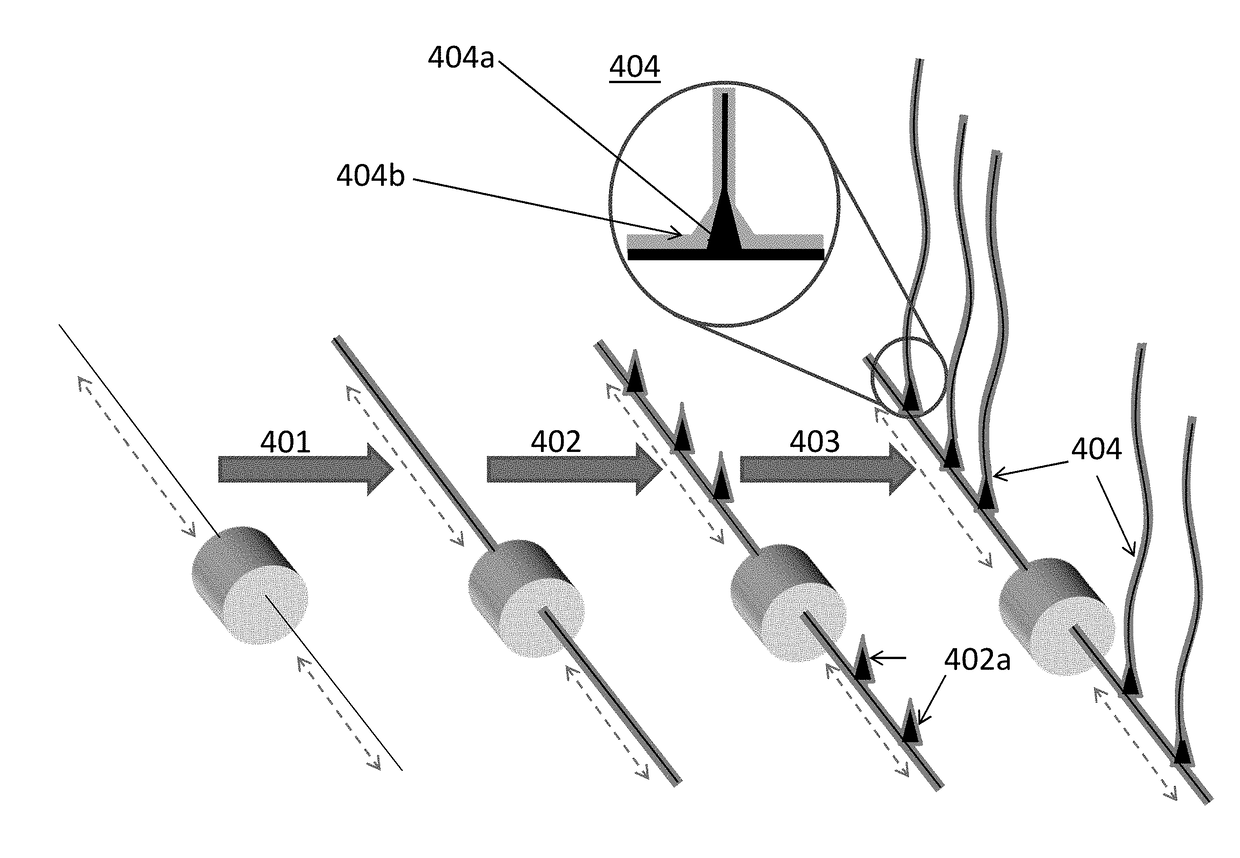Low friction core-shell nanofibrous membranes for delivery of active ingredients to the wet skin
a nano-fibrous membrane and core-shell technology, applied in the field of nano-fibrous membranes, can solve the problems of skin exposed to these conditions, slow deterioration, allergy, skin irritation, etc., and achieve excellent mobility of the membrane on the skin, good mobility of the membrane, and reduced friction at the interface of the membrane and the outer layer of the skin.
- Summary
- Abstract
- Description
- Claims
- Application Information
AI Technical Summary
Benefits of technology
Problems solved by technology
Method used
Image
Examples
example 1
[0092]Preparation of Nylon / Ascorbic Acid Solution and Ascorbic Acid Solution
[0093]Nylon was dissolved in a mixture of acetic acid and formic acid (acetic acid: formic acid=2:1 by volume) at a concentration of 12% (w / w). Ascorbic acid was mixed with the nylon solution at a concentration of 10% (w / w). The mixture was stirred at 500 rpm for 24 hours at room temperature to form the nylon / ascorbic acid solution (namely, Solution A). The viscosity of the Solution A was 910 cP. The conductivity of Solution A was 50 μS / cm. Ascorbic acid solution (namely, Solution B) was made by a process that was similar to the process for making Solution A except that nylon was excluded. The viscosity of the Solution B was 1 cP. The conductivity of Solution B was 50 μS / cm.
[0094]Fabrication of Low Friction Core-Shell Electrospun Nylon / Ascorbic Acid Fibers
[0095]Low friction core-shell electrospun nylon / ascorbic acid fiber membrane was formed on cotton fibers as collecting substrate by free-surface electrospi...
example 2
[0106]Preparation of Nylon / Urea Solution and Urea Solution
[0107]Nylon was dissolved in a mixture of acetic acid and formic acid (acetic acid: formic acid=2:1 by volume) at a concentration of 12% (w / w). Urea was mixed with the nylon solution at a concentration of 10% (w / w). The mixture was stiffed at 500 rpm for 1 hour at room temperature to form the nylon / urea solution (namely, Solution C). The viscosity of Solution C was 800 cP. The conductivity of Solution C was 80 μS / cm. Urea solution (namely, Solution D) was made by a process that is similar to the process for making Solution C except that nylon was excluded. The viscosity of the Solution D was 1 cP. The conductivity of Solution D was 80 μS / cm.
[0108]Fabrication of Low Friction Core-Shell Electrospun Nylon / Urea Fibers
[0109]Low friction core-shell electrospun nylon / urea fiber membrane was formed on cotton fibers as collecting substrate by free-surface electrospinning of Solution C and Solution D using the Nanospider (Elmarco, Czec...
example 3
[0119]Fabrication of Fibers Having Urea-Loaded Nylon Core and Ascorbic Acid Shell
[0120]Core-shell fibers having urea-loaded nylon core and ascorbic acid shell were formed on cotton fibers as collecting substrate by free-surface electrospinning of Solution B in Example 1 and Solution C in Example 2 using the Nanospider (Elmarco, Czech Republic) together with a tailor-made external winding and unwinding system. The diameter of the stainless steel collecting electrode (CE) was 0.2 mm The diameter of the stainless steel spinning electrode (SE) was 0.2 mm The sheet resistance of the antistatic collecting substrate was 101011 / sq. The distance between the CE and the substrate was 25 mm The distance between the SE and the substrate was 180 mm The applied voltage was 100 kV. The current was 0.7 mA. The temperature was 23° C. The relative humidity was 33%. The substrate speed was 20 mm / min
[0121]Characterization
[0122]FIGS. 9A and 9B show the SEM images of the electrospun fibers having urea-loa...
PUM
| Property | Measurement | Unit |
|---|---|---|
| diameter | aaaaa | aaaaa |
| diameter | aaaaa | aaaaa |
| thickness | aaaaa | aaaaa |
Abstract
Description
Claims
Application Information
 Login to View More
Login to View More - R&D
- Intellectual Property
- Life Sciences
- Materials
- Tech Scout
- Unparalleled Data Quality
- Higher Quality Content
- 60% Fewer Hallucinations
Browse by: Latest US Patents, China's latest patents, Technical Efficacy Thesaurus, Application Domain, Technology Topic, Popular Technical Reports.
© 2025 PatSnap. All rights reserved.Legal|Privacy policy|Modern Slavery Act Transparency Statement|Sitemap|About US| Contact US: help@patsnap.com



